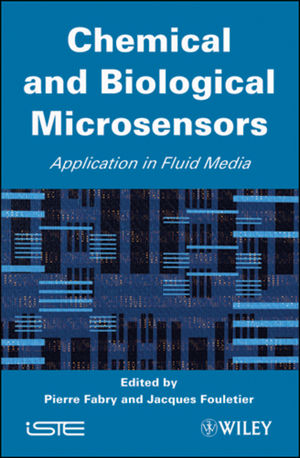Chemical and Biological Microsensors: Applications in Fluid MediaISBN: 978-1-84821-142-1
Hardcover
320 pages
January 2010, Wiley-ISTE
 |
||||||
Foreword xi
Chapter 1. General Features 1
Bernard MICHAUX
1.1. Definitions 1
1.2. Classification 6
1.3. Specific problems of chemical sensors 14
1.4. Advantages and drawbacks of chemical microsensors 21
1.5. Perspectives 22
1.6. Bibliography 23
Chapter 2. Chemical Sensors: Development and Industrial
Requirements 25
Jacques FOULETIER and Pierre FABRY, based on discussions with
Jacques FOMBON
2.1. Introduction 25
2.2. Modern research and development (R&D) management methods applied to sensors 26
2.3. Applications and inventory of the needs 33
2.4. New needs and industrial applications 37
2.5. The sensor in the measuring chain 39
2.6. Conclusions and prospects 43
2.7. Bibliography 43
Chapter 3. Sensitivity and Selectivity of Electrochemical
Sensors 45
Pierre FABRY and Jean-Claude MOUTET, and translated by J.C. POIGNET
and Pierre FABRY
3.1. General concepts 45
3.2. Models for the sensitivity and selectivity of potentiometric sensors 51
3.3. Case of amperometric sensors 64
3.4. Molecular recognition and sensors 68
3.5. Characterization methods 70
3.6. Bibliography 77
Chapter 4. Potentiometric Sensors (Ions and Dissolved Gases)
81
Annie PRADEL and Eric SAINT-AMAN
4.1. Introduction 81
4.2. Membranes 88
4.3. Current developments in potentiometric sensors 99
4.4. Bibliography 109
Chapter 5. Amperometric Sensors 115
Alain WALCARIUS, Chantal GONDRAN and Serge COSNIER
5.1. Sensors based upon chemically modified electrodes 115
5.2. Amperometric biosensors 138
5.3. Bibliography 160
Chapter 6. ISFET, BioFET Sensors 173
Nicole JAFFREZIC-RENAULT and Claude MARTELET, translated by Claude
MARTELET
6.1. Structure of ISFET sensors 173
6.2. Techniques used for ISFET fabrication and operation 180
6.3. ISFET membranes 183
6.4. Detection of molecular species 187
6.5. BioFETs 193
6.6. Commercial devices 197
6.7. Conclusion and perspectives 201
6.8. Bibliography 202
Chapter 7. Biosensors and Chemical Sensors Based Upon Guided
Optics 209
Jean-Pierre GOURE and Loïc BLUM
7.1. Introduction 209
7.2. Definitions 210
7.3. Principles of optical microsensors 213
7.4. Optical fiber biosensors 220
7.5. Perspectives and conclusions 229
7.6. Bibliography 229
Chapter 8. Sensors and Voltammetric Probes for In Situ
Monitoring of Trace Elements in Aquatic Media 233
Marie-Louise TERCIER-WAEBER and Jacques BUFFLE
8.1. Introduction 233
8.2. Basic principles of the voltammetric techniques and of their applications to analysis of water 235
8.3. Voltammetric techniques used for the analysis of trace elements in waters 244
8.4. Development of reliable submersible voltammetric probes 247
8.5. Submersible voltammetric probes reported in the literature 264
8.6. Conclusion 273
8.7. Bibliography 275
Chapter 9. Chemometrics 287
Philippe BREUIL
9.1. Introduction 287
9.2. A particular case: the linear case 290
9.3. Least squares methods: non-linear case 302
9.4. Neural networks 303
9.5. Conclusion 305
9.6. Bibliography 306
Chapter 10. Impedancemetric Sensors 307
Jacques FOULETIER and Pierre FABRY
10.1. Introduction 307
10.2. Fields of application 307
10.3. Conductivity of liquid media 310
10.4. Impedance of first kind cell (direct measurement) 313
10.5. Cell configurations and sources of error 317
10.6. Second kind cells 326
10.7. Summary of practical precautions 328
10.8. Bibliography 329
List of Authors 331
Index 335



